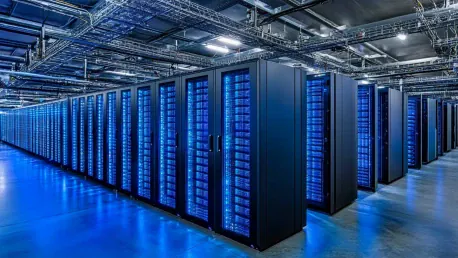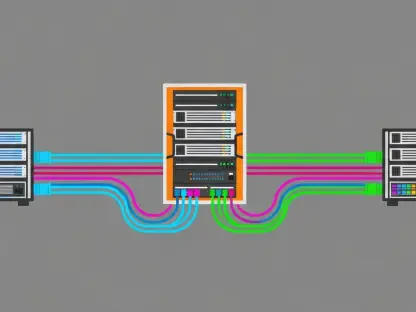The rapid growth of cloud computing has sparked a heated debate over the fate of traditional on-premises data centers. Some experts have boldly predicted their inevitable obsolescence, but recent trends and technological advancements offer a more nuanced perspective. This article delves into why enterprise data centers are likely to remain a critical component of IT infrastructure, despite the widespread adoption of cloud technology.
The Bold Prediction and Current Reality
Revisiting Gartner’s 2019 Prediction
In 2019, Gartner analyst Dave Cappuccio made a striking prediction that 80% of enterprises would shut down their traditional data centers and move entirely to the cloud by 2025. This bold statement captured the attention of the tech community and fueled discussions about the future of enterprise IT infrastructure. However, the landscape has evolved since 2019, and recent developments suggest that on-premises data centers are far from becoming obsolete.
As enterprises have navigated the challenges and opportunities of cloud adoption, they’ve encountered various obstacles that have led them to reconsider their strategies. Technological advancements, regulatory changes, and unforeseen global events have all contributed to a more complex IT ecosystem. John-David Lovelock, another analyst at Gartner, echoed this sentiment, asserting that enterprise data centers are not only surviving but are here to stay. Despite the strong trend toward cloud adoption, on-premises data centers continue to play a vital role, as evidenced by the substantial $66 billion global spending on data centers in 2024.
The Resilience of Enterprise Data Centers
The resilience of enterprise data centers lies in their ability to adapt to changing circumstances and meet the unique demands of various applications. While cloud computing offers numerous benefits, it does not render on-premises data centers obsolete. Instead, these data centers have evolved to complement cloud solutions, providing a hybrid approach that balances the advantages of both environments. This hybrid model allows organizations to optimize their IT infrastructure and achieve greater flexibility, efficiency, and security.
Global spending on data centers has remained robust, indicating continued investment and commitment to on-premises infrastructure. According to Synergy Research, the share of on-premises data center capacity has decreased from nearly 60% six years ago to 37% in 2024. However, this decline is not as rapid as previously anticipated, and on-premises data centers still account for a significant portion of the overall capacity. Hyperscale data centers, driven by the demand for AI and other advanced technologies, are expanding their capacity to meet growing needs. By 2029, hyperscalers are expected to account for more than 60% of total data center capacity, while on-premises hubs will still comprise a substantial 20%.
Applications Better Served On-Premises
Legacy Applications and Practicality
It’s a common misconception that all applications should migrate to the cloud. In reality, not every application is well-suited for cloud environments, particularly legacy applications. While it is technically possible to move these applications to the cloud, doing so may not always be practical or necessary. Factors such as security concerns, data privacy regulations, and the need for control and visibility further justify keeping certain applications on-premises.
Legacy applications have often been tailored to specific on-premises infrastructure, making a straightforward transition to the cloud challenging. Refactoring these applications for cloud environments can be a complex, time-consuming, and costly process. Moreover, maintaining control over sensitive data and ensuring compliance with data privacy regulations is often easier when applications are hosted on-premises. As a result, organizations may choose to keep certain critical applications within their own data centers to ensure optimal performance, security, and regulatory compliance.
Uptime Institute’s Findings
The Uptime Institute’s findings highlight the sustained relevance of on-premises data centers for specific applications. According to their reports, the percentage of IT workloads in corporate data centers has declined from 58% in 2020 to 48% in 2023. Despite this decrease, a notable 43% of IT workloads are projected to remain in on-premises data centers by 2025. This data underscores the enduring importance of on-premises infrastructure for certain applications that require higher levels of security, control, and visibility.
For many organizations, hybrid IT environments that combine on-premises infrastructure with cloud solutions offer the best of both worlds. This approach allows them to leverage the scalability and flexibility of the cloud while maintaining the control and security of on-premises data centers. By carefully assessing the needs of their applications and workloads, organizations can determine the most effective deployment strategy, ensuring that their IT infrastructure remains robust, secure, and efficient.
The Rise of Repatriation
Inefficiencies and Cost Overruns
The COVID-19 pandemic accelerated the transition of many applications to the cloud, often in a hasty and unplanned manner. While this rapid shift helped organizations adapt to unprecedented challenges, it also led to inefficiencies and cost overruns. As a result, organizations are now reevaluating their cloud strategies and considering repatriation—moving applications back to on-premises data centers—to address these issues.
Repatriation has gained traction as organizations recognize the limitations and challenges of cloud-only strategies. Higher-than-expected costs, security concerns, performance issues, and regulatory compliance are significant factors driving this trend. By moving certain applications back to on-premises data centers, organizations can regain control, reduce costs, and improve the overall performance and security of their IT infrastructure.
IDC’s Survey Insights
Insights from IDC’s surveys reveal that repatriation is becoming increasingly common among IT decision-makers. According to IDC, about 80% of 2,250 IT decision-makers surveyed expect some level of repatriation in the coming year. This shift reflects the growing recognition of the value of on-premises data centers in addressing the challenges associated with cloud adoption.
Organizations are learning from their experiences and adopting more strategic approaches to IT infrastructure management. By leveraging a mix of cloud and on-premises solutions, they can optimize their operations and ensure that their applications and workloads are hosted in the most appropriate environments. This hybrid approach allows them to strike a balance between the scalability and flexibility of the cloud and the control, security, and cost-efficiency of on-premises data centers.
Modernizing Data Centers with Private Cloud
Advanced Technologies in Data Centers
Modern enterprises are not simply maintaining their existing data centers; they are actively evolving and enhancing them with advanced technologies. Improvements in server power and efficiency, liquid cooling, and enhanced networking are among the innovations that are transforming traditional data centers into more efficient, cloud-like environments. These advancements enable organizations to maximize the performance and efficiency of their on-premises infrastructure.
As data centers undergo modernization, they become more capable of handling the demands of contemporary applications and workloads. This transformation allows enterprises to achieve greater operational efficiencies, reduce energy consumption, and enhance overall performance. By investing in state-of-the-art technologies, organizations can ensure that their data centers remain competitive and capable of meeting the evolving needs of their IT environments.
Private Cloud Solutions
The line between traditional data centers and cloud environments is becoming increasingly blurred as enterprises adopt private cloud solutions. Leading technology firms such as HPE, Dell, AWS, Microsoft, and Google offer private cloud solutions that can be managed within enterprise data centers. These solutions provide the benefits of cloud computing, such as scalability and flexibility, while maintaining the control and security of on-premises infrastructure.
Private cloud solutions enable organizations to create cloud-like environments within their own data centers, offering a seamless blend of on-premises and cloud capabilities. This approach allows enterprises to leverage the advantages of cloud computing without compromising on security or control. By integrating private cloud solutions into their data centers, organizations can achieve a more agile and efficient IT infrastructure that meets the demands of modern business operations.
The Growth of Edge Computing
The Surge in IoT Devices
The rapid proliferation of IoT devices has significantly impacted the IT landscape, driving the need for localized processing power and data analytics capabilities. As a result, investment in edge computing has surged, shattering the cloud-only paradigm and emphasizing a more distributed approach to IT infrastructure. Edge computing enables real-time data processing and analytics at the source, reducing latency and improving overall efficiency.
Edge computing addresses the limitations of centralized cloud infrastructure by bringing processing power closer to the devices generating the data. This localized approach is particularly beneficial for applications that require real-time processing, such as autonomous vehicles, smart cities, and industrial automation. By investing in edge computing, organizations can enhance their ability to process and analyze data quickly and efficiently, ultimately improving their operational capabilities.
IDC’s Projections
IDC’s projections underscore the growing importance of edge computing in the IT landscape. According to their estimates, global spending on edge computing is expected to reach $228 billion in 2024, with projections extending to $378 billion by 2028. This substantial investment reflects the increasing recognition of the value of edge computing in addressing the demands of modern applications and workloads.
As organizations continue to adopt IoT devices and pursue digital transformation initiatives, the role of edge computing will become even more critical. By distributing data processing and analytics capabilities across a network of edge devices, enterprises can achieve greater agility, efficiency, and responsiveness. This distributed approach ensures that data and applications reside in contextually appropriate locations, optimizing performance and enabling new business models.
AI and On-Premises Data Centers
Leveraging AI for Competitive Advantage
Artificial intelligence (AI) has emerged as a key driver of competitive advantage for enterprises across various industries. As organizations seek to harness the power of AI, they face important decisions about utilizing scalable cloud resources versus maintaining in-house control. While hyperscalers are expanding their GPU-based data centers to support AI-as-a-service models, the necessity to safeguard private data feeds demand for on-prem private clouds.
On-premises data centers offer organizations greater control over their AI workloads, enabling them to protect sensitive data and comply with regulatory requirements. This control is particularly important for industries such as healthcare, finance, and government, where data privacy and security are paramount. By maintaining AI infrastructure on-premises, enterprises can ensure that their AI initiatives are conducted in a secure and compliant manner, ultimately driving better outcomes.
The Role of Edge Computing in AI
Edge computing plays a crucial role in supporting AI initiatives by addressing latency and performance considerations. AI inferencing, which involves processing data to generate real-time insights and decisions, requires low-latency, high-performance environments. Edge computing provides the localized processing power needed for AI inferencing, enhancing operational efficiencies and enabling new business models.
By integrating edge computing with on-premises data centers, organizations can create a robust IT infrastructure that supports their AI endeavors. This blend allows enterprises to leverage the scalability of the cloud for AI training while ensuring that AI inferencing operates efficiently and securely at the edge. As AI technology continues to mature, this integrated approach will be essential for organizations seeking to maximize the value of their AI investments.
Industry Expert Perspectives
Insights from David McCarthy of IDC
Nuanced perspectives from industry experts, such as David McCarthy of IDC, highlight the dual need for leveraging public cloud AI services while protecting sensitive data within private environments. McCarthy emphasizes that organizations can benefit from both public and private cloud solutions, depending on the specific requirements of their AI workloads. This balanced approach allows enterprises to harness the scalability and flexibility of public cloud resources while maintaining control over critical data and applications.
McCarthy’s insights underscore the importance of a hybrid IT strategy that combines the strengths of both cloud and on-premises environments. By adopting this strategy, organizations can achieve greater agility and efficiency, ensuring that their IT infrastructure remains adaptable to changing business needs. This flexibility is particularly important as AI technology continues to evolve, enabling enterprises to stay competitive and drive innovation.
McKinsey’s Forecast
The rapid expansion of cloud computing has ignited a spirited discussion about the future of traditional on-premises data centers. While some industry experts confidently declare that these data centers will soon become obsolete, recent trends and technological advancements suggest a more complex reality. It is becoming increasingly clear that enterprise data centers will continue to play a crucial role in IT infrastructure, even as cloud technology becomes more prevalent.
The reason for this continued significance is multi-faceted. For one, data centers offer unparalleled control over data security and privacy, something that many organizations still prioritize highly. Additionally, they provide customization options that can be tailored to meet specific business needs, which cloud solutions may not always adequately address. Legacy systems, which are deeply integrated into many organizations’ operations, also necessitate the use of physical data centers.
High-performance computing applications, which require low-latency and high-bandwidth, are another case where on-premises data centers excel. Despite the scalability and convenience offered by the cloud, certain industries demand the precision and performance only achievable with on-premises solutions.
In summary, while cloud computing continues to grow and evolve, traditional on-premises data centers are far from obsolete. They are likely to remain an essential part of the IT landscape, providing tailored solutions for complex needs that cloud computing alone cannot fulfill.









